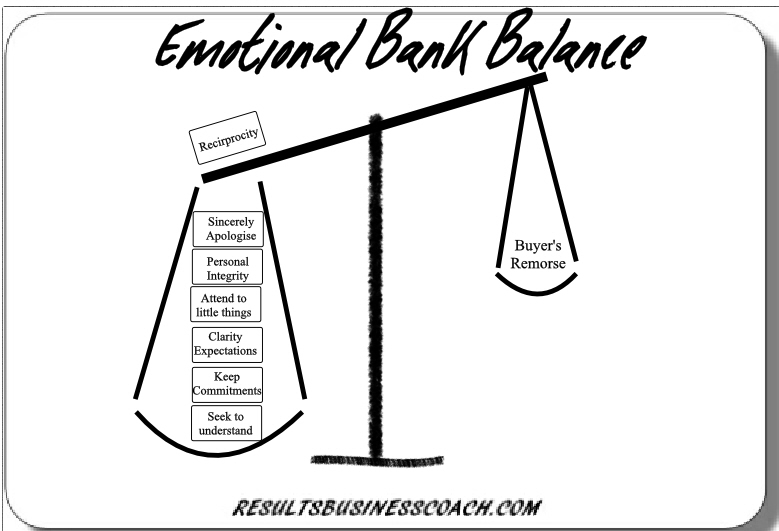 Buyer’s remorse. I am sure at some point in our life we have been through it.
Buyer’s remorse. I am sure at some point in our life we have been through it.
If you have experienced your customers change their mind after a purchase or they back off after a firm commitment then this article may be of interest to you.
The psychology of buyer’s remorse
After committing to buy a high price item, the buyer’s mind plays tricks. Questions like, “did I make the right choice?” “am I being a bit extravagant?”, or “did I fall for a sales pitch?”, starts to come out of the woodwork. These questions can sometime influence the buyer to withdraw from the sale.
Let’s talk Cognitive Dissonance
Buyer’s remorse has been connected to the psychological theory of cognitive dissonance. Cognitive dissonance is a state of discomfort that emerges when two or more elements of cognition are against each other. This discomfort nudges the person to think differently about how they think of that situation.
Your buyers are motivated to reduce the dissonance by changing existing cognitions or adding new ones in line with their consistent belief system or reducing the importance of anything that causes dissonance.
In a nutshell we are always trying to find harmony between our expectations and what we perceive to be the reality.
We try to achieve this harmony by:
- minimising the importance of one of the one of the discordant factors
- Or changing one of the discordant factors
- Or adding something else that brings consonance to our experience
The Fox and the Grapes
A good example of cognitive dissonance is told in the fable “The Fox and the Grapes”. When the Fox could not reach the desired high-hanging grapes, he decided that the grapes are NOT worth eating. He changes one of the discordant factors ‘desirability of the juicy delicious grapes’ to something else. That is, he decides that the grapes are sour and hence not worth further attempts.
How to minimize ‘buyer’s remorse’
The relationship with your buyer starts well before the purchase. It starts from the point where you buyer first contacts you with an inquiry. We have no control over our customers belief systems and how he/she will deal with their ‘buyer’s remorse’.
Before the purchase they are in ‘harmony’ with their expectations and perceived reality. Once they commit to a high investment purchase ‘disharmony’ emerges and we know they will seek ways to bring harmony back in to their life and may withdraw from the purchase.
However, if we made sure that their ‘emotional bank balance’ was in credit after the purchase we could almost help them to avoid ‘buyer’s remorse’.
What is an ‘emotional bank account’?
Stephen Covey, the author of ‘Seven Habits of highly effective People’ articulated the term Emotional Bank account. Emotional bank account refers to building harmony with potential buyers well in advance so that they (the buyers) can draw from the emotional bank account (that we help build) to counter act ‘buyer’s remorse’. We build the emotional bank balance, not with currency units, but with blocks of emotional units.
The bigger you build the emotional bank account, the higher the TRUST that buyer builds of you.
Here are Stephen Covey’s six ways to build a solid emotional bank account
- Understand the individual: As the late Stephen Covey puts it, “seek first to understand then to be understood”. Going beyond what is required and really getting to understand ‘why’ they want what they want will be a great start in getting to understand the individual. Appreciate their values. Don’t try and fit them to your expectations. (More at How to get better results for your clients and convert more prospects in to clients)
- Keep Commitments: Don’t make promises you cannot keep. Start with keeping to what you agreed. One of the easiest ways to drain the emotional bank account is to break your promises.
- Clarify expectations: None of us are mind readers. We also look at the same thing from a different point of view; hence we will have different expectations of the same thing. So be upfront with what to expect through out your relationship with your customer.
- Attend to little things: Any relationship strengthens when we go to pains to attend to little things. Simple thank you, warm smiles, or kind words can go a long way to build the emotional bank account.
- Show personal integrity: Without integrity none of the other measures of building the emotional bank account will work. Integrity has to do with keeping your word. First to yourself and then to others.
- Apologizing sincerely when we make a withdrawal: An opportunity to show we are human. We make mistakes in spite of our best efforts. Sincere apologies and genuine effort to put things write will help us maintain the emotional bank account.
And one more:
Reciprocity: Although this was not part of Stephen Covey’s list, this will add a huge amount to the emotional bank account. Reciprocation is sort of a ‘karmic piggy bank’. We always try to repay in kind what other person has provided for us. The more you give without any expectations the more trust you build with your prospects and customers. (See more at You can have anything you want – The story of 10ft chop sticks)




{ 0 comments… add one now }